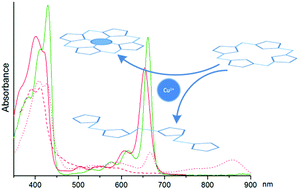Fine tuning of copper(ii)–chlorophyll interactions in organic media. Metalation versus oxidation of the macrocycle†
Abstract
The nature of chlorophyll interactions with copper(II) ions varies considerably in organic solvents, depending on the dominant coordinative form. Besides formation of the metallo tetrapyrrolic complex, Cu(II) ions can cause oxidation of the pigment, reversible or irreversible, which can lead to the destruction of the macrocyclic structure. All these reaction types can be distinguished within a quite narrow range of reaction conditions. The ability to form new metallo derivatives in either metalation or transmetalation reactions is obviously limited by the concentration of the potential oxidant, but can be secured below this level via suitable composition of the reaction system. The decisive factor in the selection of a specific reaction pathway is the presence of a potential ligand that can affect the reactivity of Cu(II) for example by shifting its redox potential. Spectroscopic and electrochemical studies were performed in order to determine the predominant species of Cu(II) in methanol, nitromethane and acetonitrile in the presence of chloride and acetate ions, as well as to assign their appropriate oxidizing ability. This allowed us to estimate the boundary conditions for the electron transfer processes in chlorophyll–Cu(II) systems. Chlorophyll and its free base can undergo both types of electron transfer processes, however, they reveal different susceptibilities that make this class of ligands quite versatile markers in tuning the reactivity of metal ions in solutions.


 Please wait while we load your content...
Please wait while we load your content...